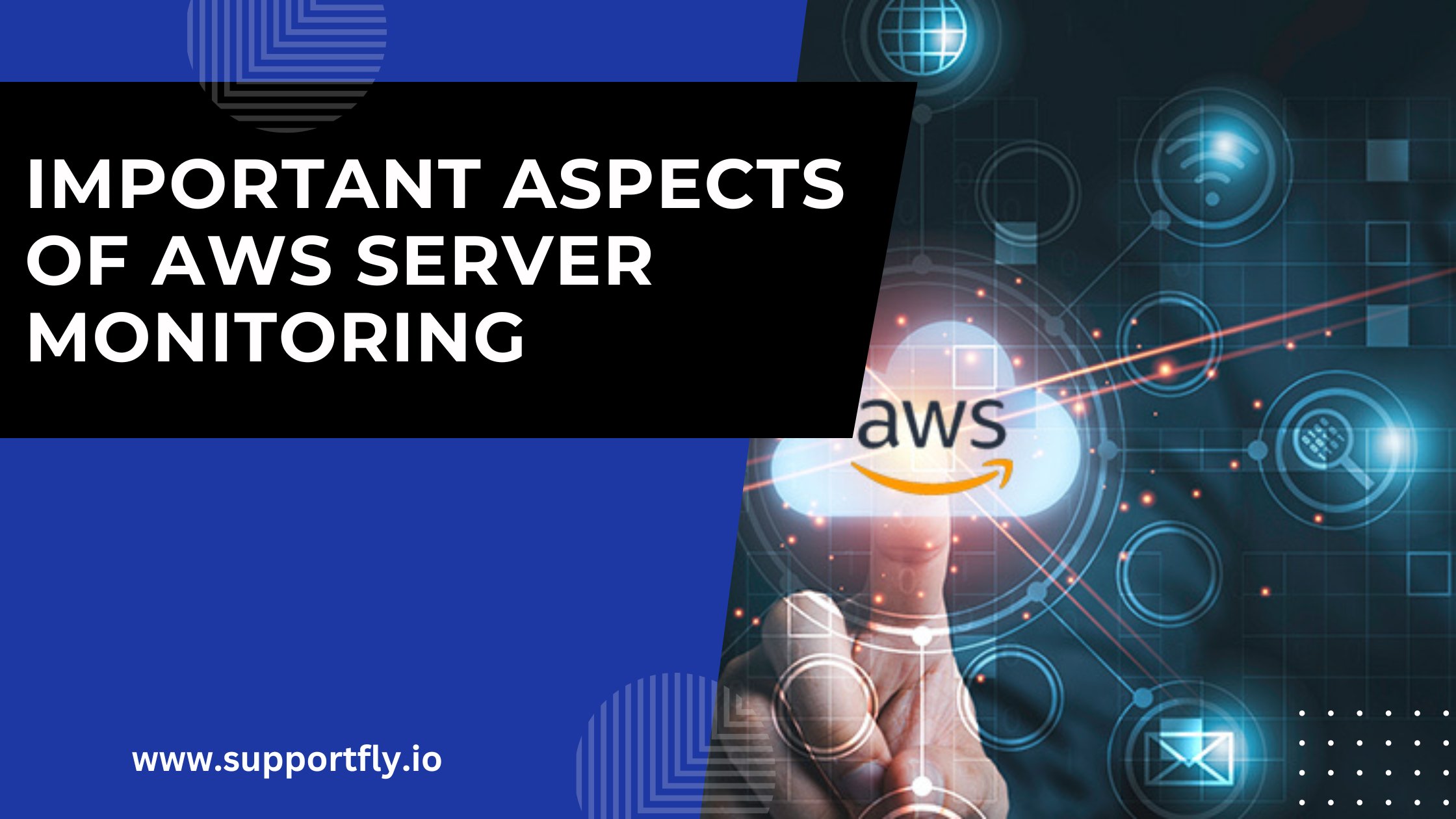Important aspects of AWS server monitoring
In this blog post, we will discuss the important aspects of AWS server monitoring and how to effectively monitor your AWS servers to ensure maximum uptime and performance.

Amazon Web Services (AWS) is one of the most widely used cloud computing platforms in the world, providing businesses with reliable, scalable, and cost-effective infrastructure for their applications and services. While AWS offers many benefits to users, it is important to monitor the performance and health of your servers to ensure they are running optimally and to identify any potential issues before they become critical. Getting AWS server support from professionals like SupportFly is one good option. They will handle all the AWS server technicalities so that you can focus on your business.
In this blog post, we will discuss the important aspects of AWS server monitoring and how to effectively monitor your AWS servers to ensure maximum uptime and performance.
What is AWS Server Monitoring?
AWS server monitoring refers to the process of monitoring the health, performance, and security of servers that are hosted on the Amazon Web Services (AWS) cloud platform. AWS server monitoring typically involves using various monitoring tools and services to collect data on server performance, including metrics related to CPU usage, memory usage, disk utilization, network bandwidth utilization, and more.
AWS offers a range of monitoring tools and services, including Amazon CloudWatch, which provides detailed metrics and insights into the performance of AWS resources, and Amazon GuardDuty, which is a threat detection service that continuously monitors for malicious activity and unauthorized access to AWS resources.
Effective AWS server monitoring can help businesses to identify potential issues and troubleshoot problems before they become critical. It can also help businesses to optimize their AWS usage, reduce costs, and ensure that their AWS resources are running efficiently and cost-effectively.
Important aspects of AWS Server Monitoring
Availability and Uptime Monitoring
The first and most important aspect of AWS server monitoring is availability and uptime monitoring. This involves monitoring the health of your servers and ensuring that they are available and responsive to incoming requests.
AWS provides a number of tools to monitor availability and uptime, including Amazon CloudWatch, which provides monitoring and alerting services for AWS resources. CloudWatch enables you to monitor your AWS resources, including EC2 instances, RDS databases, and Elastic Load Balancers, and to receive notifications when certain thresholds are breached.
In addition to CloudWatch, AWS also offers Amazon Simple Notification Service (SNS), which enables you to send notifications to a variety of endpoints, including email, SMS, and mobile push notifications, to alert you when issues arise.
Performance Monitoring
Performance monitoring is another important aspect of AWS server monitoring and involves monitoring the performance of your servers and applications to ensure they are running optimally. This includes monitoring CPU usage, memory usage, disk utilization, and network bandwidth utilization.
AWS offers several tools for performance monitoring, including Amazon CloudWatch, which provides detailed metrics and insights into the performance of your AWS resources. Additionally, AWS offers Amazon CloudTrail, which provides visibility into user activity and the API usage and can help you identify performance issues and bottlenecks.
Security Monitoring
Security monitoring is critical for ensuring the safety and security of your AWS resources. This involves monitoring for potential security threats, such as unauthorized access, data breaches, and other security incidents.
AWS provides a variety of tools for security monitoring, including Amazon GuardDuty, which is a threat detection service that continuously monitors for malicious activity and unauthorized access to your AWS resources. Additionally, AWS offers Amazon Inspector, which provides automated security assessments to help identify security vulnerabilities and compliance issues.
Log Monitoring
Log monitoring is another important aspect of AWS server monitoring, and involves monitoring the logs generated by your applications and servers to identify potential issues and troubleshoot problems.
AWS provides several tools for log monitoring, including Amazon CloudWatch Logs, which enables you to monitor, store, and access your logs from a centralized location. Additionally, AWS offers Amazon Kinesis Data Firehose, which can help you stream and analyze log data in real time, providing valuable insights into your application and server performance.
Cost Optimization
Cost optimization is a critical aspect of AWS server monitoring, and involves monitoring your AWS resources to identify areas where you can save money and reduce costs. This includes identifying underutilized resources, optimizing resource usage, and identifying opportunities to use reserved instances and spot instances.
AWS offers several tools for cost optimization, including Amazon Cost Explorer, which provides insights into your AWS spending and can help you identify opportunities to reduce costs. Additionally, AWS offers AWS Trusted Advisor, which provides recommendations for cost optimization, security, and performance based on best practices and AWS service usage.
How to do effective AWS Server Monitoring?
To perform AWS server monitoring effectively, you should follow these best practices:
Define your monitoring requirements
Start by defining your monitoring requirements and what metrics and data you need to track. This includes setting up alerts for critical metrics and establishing baseline performance metrics for your servers.
Use AWS support services
AWS provides a range of monitoring services, such as Amazon CloudWatch, AWS Config, and AWS CloudTrail. These services provide real-time monitoring and alerting for your AWS resources, including EC2 instances, RDS databases, and more. If you think that managing all these is complicated, you can always visit SupportFly and get industry-leading AWS server management services.
Leverage third-party tools
Consider using third-party monitoring tools to gain additional insights into your AWS resources. For example, Datadog and New Relic are popular monitoring tools that integrate with AWS and provide additional monitoring capabilities.
Monitor logs
Use log monitoring tools, such as Amazon CloudWatch Logs and Amazon Kinesis, to collect and analyze log data. Logs can provide valuable insights into server and application performance, as well as security issues and other potential problems.
Use automation
Use automation tools, such as AWS Lambda, to automate monitoring tasks and reduce the amount of manual monitoring required. For example, you can create Lambda functions that automatically scale resources based on certain performance metrics.
Establish alerting
Set up alerts and notifications for critical metrics and events. AWS offers a range of notification services, such as Amazon SNS and AWS CloudFormation, that can alert you via email, SMS, or other channels.
Continuously review and optimize
Continuously review your monitoring setup and optimize it as needed. This includes identifying new metrics to monitor, adjusting thresholds and alerts, and updating your monitoring tools as necessary.
Conclusion
AWS server monitoring is critical for ensuring the availability, performance, and security of your AWS resources. By monitoring your AWS resources using the tools and services provided by AWS, you can identify potential issues and troubleshoot problems before they become critical. Additionally, by optimizing your AWS usage and reducing costs, you can ensure that your AWS resources are running efficiently and cost-effectively.
FAQs
What is AWS server monitoring?
AWS server monitoring is the process of tracking the performance and health of servers hosted on the Amazon Web Services (AWS) cloud infrastructure.
What are some of the key benefits of AWS Server Monitoring?
AWS server monitoring provides several benefits, including improved system performance, better security, increased uptime, and reduced downtime.
How is AWS Server Monitoring implemented?
AWS server monitoring can be implemented using various tools and services such as Amazon CloudWatch, AWS Config, and AWS Systems Manager. These services enable users to monitor server metrics, track changes to server configurations, and manage server instances.
What metrics can be monitored using AWS Server Monitoring tools?
AWS server monitoring tools can monitor a wide range of metrics, including CPU utilization, memory usage, disk I/O, network traffic, and server response time.
How does Amazon CloudWatch help in Server Monitoring?
Amazon CloudWatch is a monitoring service that provides real-time visibility into the performance of AWS resources such as servers, databases, and applications. It enables users to monitor server metrics, set alarms, and view logs.
How does AWS Systems Manager helps in Server Monitoring?
AWS Systems Manager is a management service that enables users to automate server management tasks, including server monitoring. It provides features such as Run Command, which allows users to run scripts and commands across multiple servers, and Maintenance Windows, which enables users to schedule maintenance tasks.
How does AWS Config help in Server Monitoring?
AWS Config is a service that enables users to track changes to AWS resources, including servers. It provides a detailed inventory of server configurations and enables users to track changes to configurations over time.
What's Your Reaction?




















